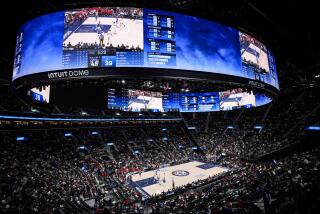Planning for Arena Hits Lull : Source of Funding Major Obstacle Facing CSUN Administrators
- Share via
A site has been located and preliminary blueprints are in hand.
Just a few more details--such as who will manage it, who will play in it, and who will pay for it--and construction of an arena at Cal State Northridge can get under way in earnest.
Currently on the wish list is a 10,000-12,000-seat facility to which Northridge basketball and volleyball teams would have complete access. The situation would only be considered ideal, of course, if there was constant cash flow.
So, do you believe in Santa Claus? Fairy godmothers perhaps?
A few colleges are lucky. UCLA has a home, Pauley Pavilion, that fits Northridge’s prerequisites.
Pauley Pavilion--which cost more than $5 million when was it built in 1965--was funded by 3 sources. The state chipped in $2 million, the students $1 million, and alumni more than $2 million. UCLA has complete control of what is booked for its 12,543-seat facility.
Most other schools, even ones with nationally ranked teams, don’t have that luxury.
Many share arenas with professional teams or other colleges. Some pay rent to play in city- or county-owned facilities. Other teams play at sites that are owned and operated by student-government groups or another auxiliary of the college.
Whatever its decision, Northridge apparently won’t have to worry about paying rent--at least not to an off-campus group.
A committee already has recommended 2 areas on campus as suitable sites for the arena. Favored by Athletic Director Bob Hiegert is the parking lot near the intersection of Zelzah and Plummer streets at the east end of the school. The other is a lot north of the college’s engineering building, just south of Halsted Street toward the center of campus.
Elliott Mininberg, an administrative vice president, has delivered both proposals to CSUN President James W. Cleary.
Hiegert favors the first option because he says the area is less restrictive, there is easier street access and it is closer to existing athletic offices. The lost parking space, he says, can be replaced by the construction of a tiered parking structure adjacent to the arena.
And how to pay for that?
“That’s one of the things we haven’t addressed yet,” Hiegert said.
The truth be told, there are many problems that Northridge officials have not even begun to work out. For now, officials appear to be fairly content just knowing that a) sentiment favors construction of such an arena; and b) there is room on campus to construct one.
CSUN’s ascendancy to major-college athletics is less than 2 years away, however, and time is becoming more of a factor.
“We’re going to have a heck of a team in a Division I setting without a major arena,” Hiegert said.
Then he added, “Urgency is something where you can worry yourself to death and never get anywhere.”
Resolutions for the early part of next year include sorting out the rest of the puzzle.
“Now that we know there is interest, we’ll start concentrating on seeing if we can get some people excited and get a major fund-raising drive going,” Hiegert said.
One person Hiegert already has contacted is Gary Leff, a CSUN graduate and part owner of the Mid-Valley Racquet Club.
Leff, a real estate developer and entrepreneur, has been asked to be an adviser as Northridge officials begin to formulate a plan of attack. He is convinced that CSUN is unaware of its resources.
“There are an awful lot of people in the Valley,” Leff said. “It’s a mature city area and I think it can support a facility, not just for athletics but also for other entertainment. People out here dread going to any events in the city.”
Hiegert would prefer to finance the arena entirely with private donations, although some alternatives might be quicker.
“With donors you have control,” Hiegert said. “Other ways are faster, but cause more problems.
“I talk to administrators from other Division II and Division I-AA schools that have multipurpose facilities they share and most of them tell me, ‘We wouldn’t do it again. We’d rather wait and get our own . . .’ ”
A cooperative venture between Northridge and the Los Angeles Clippers professional basketball team will be discussed in a Jan. 13 meeting between representatives from both sides. Hiegert has doubts that such a setup will prove feasible, however.
“It’s not like we’re talking about two different seasons,” Hiegert said. “When they overlap, who is supposed to give?”
Another possibility was to ask Northridge students to pay for all or part of the construction by passing a referendum to increase semester fees.
The cost of a 10,000-seat arena has been estimated at about $10 million, meaning it would take more than $300 from each of CSUN’s 30,000 students to completely fund the project.
The chances of that? Slim, says Lynn Westlund, the president of CSUN’s associated students.
“I don’t see the students funding the whole thing,” Westlund said. “I don’t think an arena of this size, a project of this magnitude and advancement, should be pressed solely on the students.”
And if it is?
“Then I think you have to look at who is going to manage it,” Westlund said. “I’m saying if we put in 100% of the money, then we’ll manage it.”
Westlund favors a plan similar to the one that financed Pauley Pavilion--a joint effort among students, the state and private donors.
Such a process would have to include communication among many people. Leff says the more people involved the better. At least during the preliminary stages.
“The first step is gathering hard facts--just getting people to run out and get the information you need,” Leff said.
This, he says, includes talking to prospective funding sources, business executives, promoters and arena managers.
“Maybe they’ll tell us we’re crazy,” Leff said. “Or maybe they’ll say, ‘You can only expect this much money.’ Whatever they say, we’ll put it all together and figure out what is best.”
Leff went so far as to suggest that Northridge use its own business school in the process of gathering information.
“What better way to learn than working on an actual project?” he said. “And they wouldn’t have to pay for it. It would just take somebody to orchestrate things.”
Whichever way Northridge officials eventually decide to fund the arena, CSUN’s teams won’t be breaking it in for quite some time.
“We’ll be lucky to get it done in a five-year period,” Hiegert said. “Ten years would probably be more realistic.”
Westlund says the sooner the better--not only for CSUN’s athletic teams, but also for school pride.
“It’s kind of scary even thinking about asking teams to come into our gym,” she said. “We’re saying, ‘This is our university. We have 31,000 students here and facilities that are 80-million years old.’ That’s embarrassing.”
More to Read
Go beyond the scoreboard
Get the latest on L.A.'s teams in the daily Sports Report newsletter.
You may occasionally receive promotional content from the Los Angeles Times.







